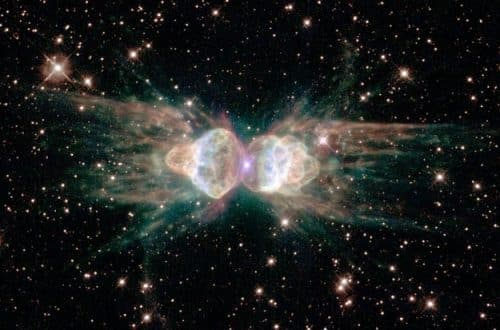A rare phenomenon associated with the death of a star has been discovered in observations made by the European Space Agency's Herschel space telescope: an unusual laser emission from the spectacular Ant Nebula, indicating the presence of a double star system hiding at its heart

As small to medium-sized stars like our Sun approach the end of their lives, they eventually become white dwarfs. In this process, their outer layers of gas and dust are thrown into space, and they create a kaleidoscope of complex formations - planetary nebulae.
Herschel's infrared observations showed that the dramatic death of the central star at the heart of the Ant Nebula is even more dramatic than its iridescent appearance in visible light images such as those taken by the Hubble Space Telescope. The new observation showed that the Ant Nebula also emits intense laser radiation from its core.
While lasers in everyday life may have special visual effects in music at concerts - in space, the focused emission is detected at different wavelengths under certain conditions. Only very few infrared lasers in space are known.
The evolution of the stars
Astronomer Donald Menzel first noticed and classified this planetary nebula in the 3s (it is officially known as Menzel 1960). He was also one of the first to claim that under certain conditions of "natural light amplification by the emission of forced radiation emission" (from which the acronym LASER was formed) - a gas nebula may develop. This was long before the discovery of the first successful operation of lasers in laboratories in 16, an event which is celebrated every year on May XNUMX as the International Day of Light.
"When we look at Menzel 3, we see an incredibly complex structure made up of ionized gas, but we cannot see the object at the center of it that produces this pattern," says Isabelle Elman, lead author of a paper describing the new findings.
"Thanks to the wide wavelength range sensitivity of the 'Herschel' space telescope, we detected a very rare type of emission known as "laser recombination hydrogen line emission", which provided a way to reveal the structure of a nebula and the physical conditions that prevail in it."
This type of laser emission requires very dense gas close to the star. Comparing the observations with the models showed that the density of the laser-emitting gas is 10,000 times higher than that of the gas seen in typical planetary nebulae and in the lobes of the Ant Nebula itself.
Normally, the region closest to the dead star - close in this case to Saturn's distance from the Sun - is quite empty, because most of its material has been ejected. Any luminous gas will fall back into the core of the star.
"The only way to keep gas close to the star is if it surrounds it in a disk," says author Albert Zijlstra. In this case we observed a compressed disk in the center that we see roughly from the side. This direction helps to amplify the laser signal. The disc indicates that the white dwarf has a binary partner (double star), so it is difficult to get the falling gas to enter orbit around it, unless the companion star rotates it in the right direction."
Astronomers have not yet seen the predicted second star, but they think that the mass from the dying companion star is ejected and captured by the central compact star of the protoplanetary nebula, which produces the disc where the laser emission is produced.
"We used 'Herschel' to characterize various components of gas and dust in nebulae around old stars, but we weren't necessarily looking for a laser phenomenon," adds Toshiya Uta, lead researcher of the 'Herschel' Planetary Nebula Survey Project. "Such emission has only been detected in a few objects before; It was an extraordinary discovery that we did not expect. There are certainly more star nebulae than we can see with the eye."
"This study shows that the unique Ant Nebula as we see it today was created by the complex nature of a binary star system, which affects its shape, chemical properties and evolution at this stage of the star's life. says Goren Filbrat, a scientist in the 'Herschel' project.
Herschel has the perfect observation capabilities to spot this unusual laser in the Ant Nebula. The findings will help constrain the conditions under which this phenomenon occurs, and help us refine our models of stellar evolution. It is also gratifying that 'Herschel' was able to link Menzel's two discoveries from almost a century ago."
For information on the European Space Agency website
More of the topic in Hayadan:

2 תגובות
There is no explanation what causes the laser
If this is a translation, it is not very successful